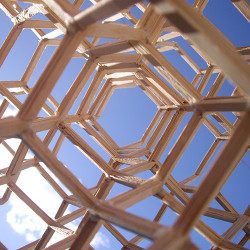The foundation was laid over two months of research, brainstorms, and prototypes. A grueling, incessant march of abstract style, design principles, and tech evaluation. My game’s prosperity depends on a good foundation, but progress was slow. Don’t misunderstand, I was happily enjoying all of it, but at some point I needed to start the game itself.
That point was a couple weeks ago. After outlining an entire gameplay design document, I began creating a framework to support it. This was a completely new endeavour — of course I used the knowledge I’d developed in the past few months, but I started from a blank sheet. Earlier work was analogous to a sculptor’s sketches; now I would put chisel to marble. Daunting.
…And Done
The entire process took a mere seven days. It’s hard to not smile at that, so allow me a hubristic moment: I’m a wizard. Well, in truth, I’m a software engineer — or, at least, I started as one. With an exact diagram of my goal and my knowledge of the required technology, the actual production was surprisingly effortless. Prototyping works. The foundation was worth it.
Removing metaphors, what is this framework actually? It’s every gameplay component, completely finished. All the content — the artwork, the story — is placeholder, but I now have a format for writing a story and playing it from start to finish.
More specifically, players now see a map of San Francisco with clickable nodes. Clicking a node shifts their perspective to a specific location and displays a descriptive paragraph. They can converse with any characters in the same place or search it for clues — any important information automatically saved in their notes. Players can then question any character about notable details, or they can move to another location.
Characters change their location based on time of day and day of the week — a baker will be at his bakery during a weekday, but at night he goes home. Certain characters might even excuse themselves mid-conversation if they pressingly need to leave.
A living world, with all the necessary tools for solving a mystery.
Completely Incomplete
Now all I need is a murder. As mentioned, everything is placeholder. The story is only a few paragraphs long, has a whopping three locations, two suspects, and three possible conversations. Not exactly War & Peace. The artwork, too, is rough — squished and stretched pieces from earlier concepts, or random images via the internet, lacking any animation. A world of possibilities, fantastically barren. But my goal is simple: populate this world.
The End Is the Beginning
Throughout this post I’ve called the framework “done”. In truth, I should use the more accurate “functional”. Yes, I can now create a game from start to finish. Is that game any good? I think it will be, but crystal balls are beyond my current budget. After writing a story, if playing the game isn’t fun, the framework will change. Hell, even if playing is fun but I have a good idea, the framework will change. But, crucially, the framework now exists. I now write a story, play it from start to finish, and truly iterate — not just brainstorm ideas, but refine the game, its actual code. A smaller form of iteration, with hopefully shorter cycles, but just as important as prototyping the foundation.
Let’s get to work!
Background image via Astris1
